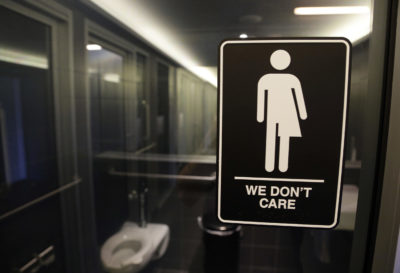
Bethany Grace Howe
Why do I tell you this? Because when I knew Bethany back then, I knew her as Barton. We stayed in touch after she graduated, as she married, had a daughter, worked for a small newspaper, went back to her first love of teaching, came out as gay and then, about five years ago, came out as transgender. She went on to teach and earn a Ph.D. at the University of Oregon, and now does community work with wildfire-devastated communities for the state of Oregon.
She has written about it all — on Facebook, for BuzzFeed, in speeches and more. She came back to the Missouri J-school a couple of years ago and gave endless talks to endless groups of curious students. Her shorthand for them was “Transgender 101.” Being schooled by nuns as I was in a few formative years, and knowing Bethany’s sense of humor as I do, I always thought of them as “Sister Bethany Grace Explains It All to You.”
When I began to pull together some Storyboard posts for Pride Month, I couldn’t think of a better person to cap the collection than Bethany. She graciously agreed to write a version of “Explains It All,” in which she shares a bit of her personal journey, and offers tips to working journalists about how to, and not to, interview trans people.
I consider it a must read. For those who winced when I used the name I met her by — what many trans people call their “dead name” — Bethany addresses that. She also deals directly with the bathroom issue, which she makes memorable with a riff on bathroom tissue.
Navigating transgender stories without a style guide
 Change is often used as a marker of time. How much progress has been made in how long? How much remains to be done? Those mileposts can be especially significant in the progress — or lack of it — in social justice movements. Viewed through the long lens of history, that change can be easier to see. Viewed more immediately, we can sometimes lose sight of how recent much of our history is.
Change is often used as a marker of time. How much progress has been made in how long? How much remains to be done? Those mileposts can be especially significant in the progress — or lack of it — in social justice movements. Viewed through the long lens of history, that change can be easier to see. Viewed more immediately, we can sometimes lose sight of how recent much of our history is.
I was reminded of that when I pulled up a story Lane DeGregory wrote in 2002 for the St. Petersburg Times (now the Tampa Bay Times). DeGregory can turn almost any event, no matter how ordinary, into a never-thought-of-it-that-way feature, and any person, no matter how flawed, into a profile that is both unflinching and empathetic. Her open-hearted curiosity for humanity finds something relatable in the most challenged among us.
Twenty years ago, DeGregory turned that help-me-understand gaze on several stories involving transgender people. One of those people was Madalynn Shepley, whom DeGregory introduced to us as Maddie. Maddie was a mechanic, a homeowner, a husband, and a father of four — all things she gave up to become who she knew herself to be: a woman.
DeGregory’s profile, “The Making of Maddie,” is a story that surprises on multiple levels, and worth your time as you ponder the dimensions of love. Our annotation of the profile, and our conversation with DeGregory, adds layers of context about the limits of knowledge when DeGregory sought to understand Maddie’s life. Previous stories about gender transition often focused on celebrities — think Renée Richards — or on medical curiosity. Caitlyn Jenner, perhaps the most famous openly trans person, didn’t announce her transition until 2015, which is the same year Time magazine featured a cover story on the “Trans Tipping Point.” The official manual of mental disorders listed transgender identity as a “disorder” until 2013, when it was redesignated “gender dysphoria.” And at a very basic level, the subject wasn’t addressed in journalism style guides.
DeGregory was reporting and writing without a map. As she told Storyboard, she only had Maddie, one area therapist, and her own instincts to rely on for understanding, tone and word usage.
This isn’t ancient history. It was not even 20 years ago. But DeGregory spotted a few places in her profile that, were she writing the piece now, she would reframe. That underscores the care journalists must take when writing history as it happens.
Finding — and fearing — your voice

Transgender teen Chloe Clark near her home in St. Louis, Missouri, in March 2020.
Fast forward — or to those living it, slow forward — from Maddie Shepley in 2002 to Chloe Clark in 2021. Chloe came out to her parents two years ago, when she was 13. With their support, she began her transition. She was blossoming — comfortable with friends, doing well in school, finding her look and her this-is-who-I-am voice.
But her physical voice wasn’t keeping pace. She could look in the mirror and see Chloe; when she spoke, she didn’t sound like she felt. She was working with a speech therapist to raise the pitch of her natural voice — one of the many adjustments, large and small, she had to make to match how the world knew her with how she knew herself.
Then the COVID shutdown came. The isolation meant school and social activities were lived on Zoom, and that meant many people met and knew Chloe primarily by the sound of her voice. She had finally found the courage to speak her truth — only to silence herself again.
Fortunately for us, she opened up to Samantha Schmidt of The Washington Post. Schmidt’s reporting started before the pandemic and then, in a bit of a parallel to Chloe’s withdrawal, was put on hold. But Schmidt put that time to good use — in another and perhaps ironic parallel, using Zoom — to do contextual reporting and to get to know Chloe much better; she shadowed her in classes and sat in on family dinners. The time lag also allowed her to hear Chloe’s silence. That became the core metaphor that framed the girl’s life, and thus the story.
Our conversation with Schmidt, and annotation of her profile of Chloe, offer lessons in choosing story subjects, negotiating ethical relationships, reporting intimate situations in person and at a distance, finding a story focus, and building a structure to support it.
A mirror for changing times

A gender-neutral bathroom sign at a hotel in Durham, N.C., in 2018
Journalism is only a partial reflection of society at any given time. But we need, at least, to widen our lens and not fall too far behind as it evolves lest we get stuck in a false frame of reality. Ideally, we watch with acuity as shifts take place and, like a good sports photographer, anticipate and get slightly ahead of the action.
The posts linked to above are a reminder of that. The strategies suggested by Howe, and used by DeGregory and Schmidt, apply to any good story work, but are especially important to master when covering sensitive subjects. That’s not inappropriate advocacy, as some fear. It’s good and necessary journalism.
For another insider view of the battle for transgender awareness and rights, read this insightful essay in today’s New York Times, by Thomas Page McBee, a newspaper editor, author, screenwriter, and the first trans man to box in Madison Square Garden. He discusses gender as a language rather than a fixed physicality, and refers to the “messy humanity” of trans people. I would argue that term applies to all of us.
A version of this post first ran as a Storyboard newsletter on June 25, 2021.


